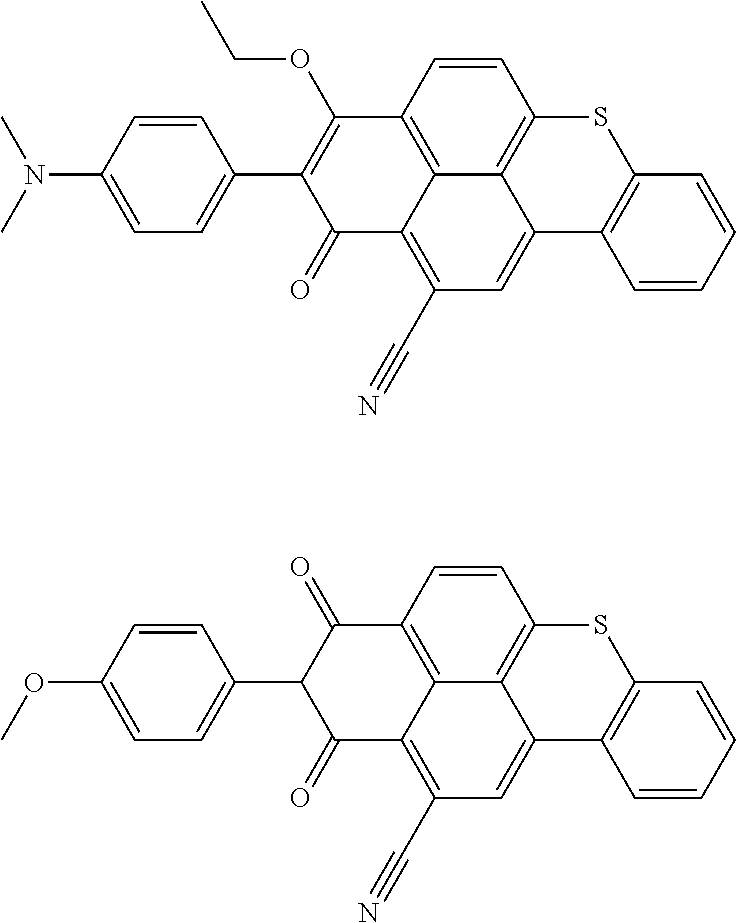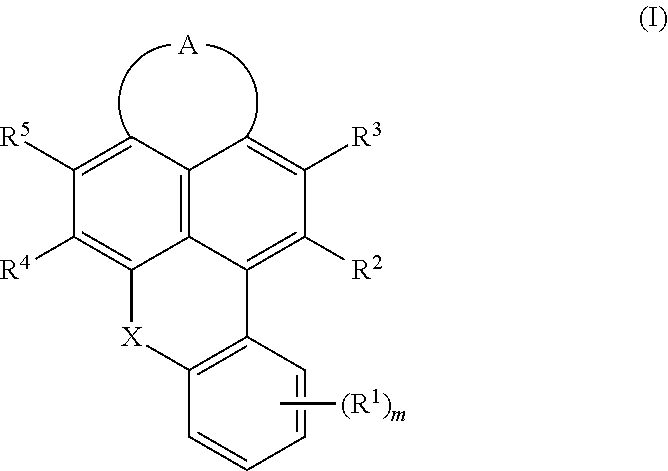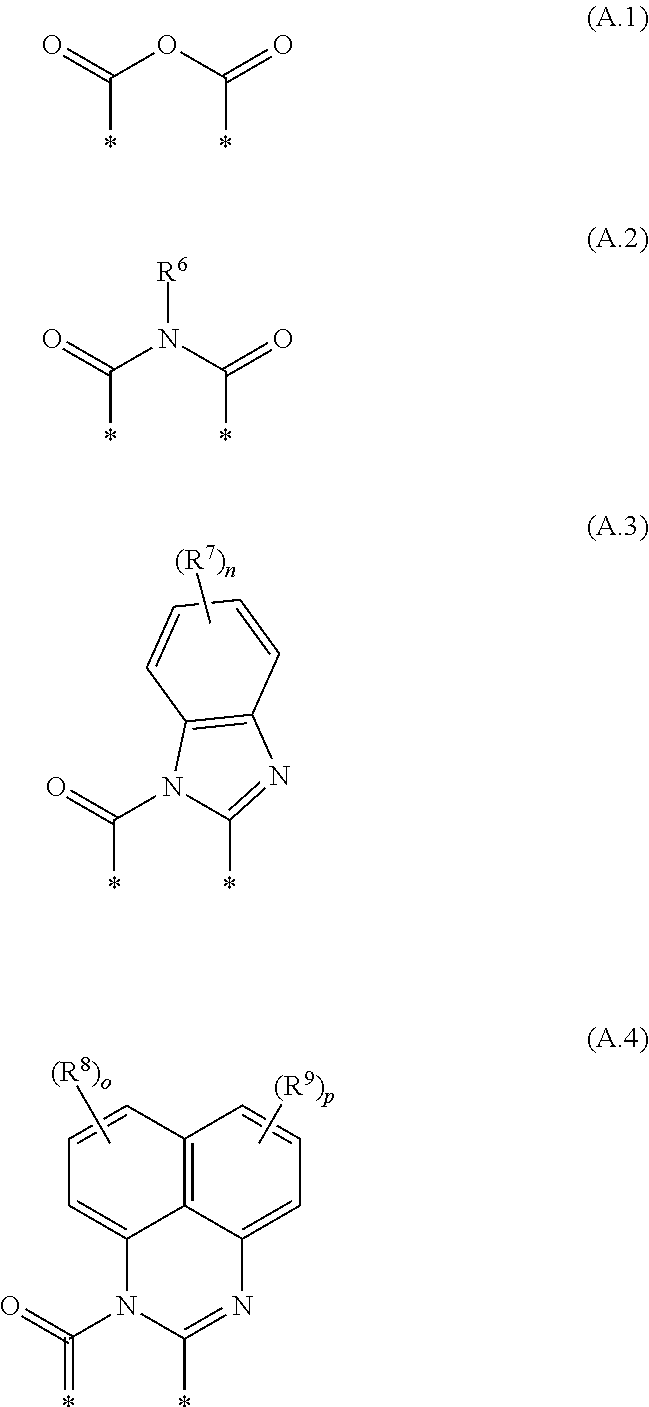Cyanated benzoxanthene and benzothioxanthene compounds
a technology of cyanated benzoxanthene and benzothioxanthene, which is applied in the field of new compounds, can solve the problems of complex multi-led technology, inability to meet the requirements of organic luminophore materials, and limited component miniaturization of multi-led, so as to improve the stability and life of inventive compounds and high fluorescence quantum yields
- Summary
- Abstract
- Description
- Claims
- Application Information
AI Technical Summary
Benefits of technology
Problems solved by technology
Method used
Image
Examples
example 1
[0382]
[0383]A mixture of 0.5 g (0.83 mmol) of 5,11-dibromo-2-(2,6-diidopropylphenyl)-1H-xantheno[2,1,9-def]isoquinoline-1,3(2H)-dione (prepared as described in WO 2014 / 131628, example compound 2404) in 20 mL of N-methylpyrrolidone (NMP) and 0.179 g (2 mmol) of CuCN were heated to 170° C. After 2 hours, further 0.1 g of CuCN were added and after 3 further hours, further 0.1 g of CuCN were added. The reaction mixture was cooled after admixed with water, filtered, and washed with methanol. The residue was chromatographed with toluene / ethyl acetate (20:1) on silica gel. This gave 250 mg (61%) of the title compound. Rf: 0.56.
[0384]Absorption: λmax (CH2Cl2): 427; emission: λmax (CH2Cl2): 497 nm; FQY (CH2Cl2) 100%
example 2
[0385]
[0386]2.1 Preparation of
[0387]The title compound was prepared according to Guttsait, A. V.; Balodis, K. A.; Meirovits, I. A. Chemistry of Heterocyclic Compounds (New York, N.Y., United States), 1993, vol. 29, No. 10 p. 1226 - 1229.
[0388]2.2 Preparation of
[0389]A mixture of 56 mL of chlorobenzene, 40 mL of water, 5.0 g (9 mmol) of the compound of example 2.1 and 45.2 g (285 mmol) of bromine were reacted at 35° C. for 16 hours. Bromine was blown out with nitrogen and the product was precipitated with ethanol, filtered and washed with water. The title product was obtained in quantitative yield (6.7 g). Rf=0.72 (toluene)
[0390]2.3 Preparation of
[0391]A mixture of 1.0 g of the compound of example 2.2, 34 mL of NMP and 0.627 g of CuCN were heated to 160° C. After 1 hour further 0.2 g of CuCN were added. One hour later further 0.2 g of CuCN were added and the reaction was heated for 16 hours. The product was precipitated by the addition of water, filtered and dried. The crude product ...
example 3
[0393]
[0394]3.1 Preparation of
[0395]A mixture of 400 mL of NMP, 15 g (54.14 mmol) of 4-bromo-1,8-naphthalic anhydride, 19.98 g (140.76 mmol) of 2-nitrophenol, 7.15 g of KOH (108.28 mmol) and 0.24 g (3.79 mmol) of Cu powder was stirred at 130° C. for 21 hours. After cooling to room temperature, the mixture was poured onto diluted sulfuric acid. The precipitate was filtered off and vacuum dried at 70° C. The solid was stirred in acetone, dissolved in DCM, filtered and vacuum dried at 70° C. to give 11.72 g (34.96 mmol, 64.6%) of a beige solid.
[0396]Rf (toluene / EE / HAc 10 / 2 / 1)=0.51. Purity: 91.4% (HPLC (254 nm)). m / z=336.0 (M+H) Rt=1.111 min (LCMS, ESI).
[0397]3.2 Preparation of
[0398]To a mixture of 450 mL of DMF, 5.72 g (17.06 mmol) of the compound from example 3.1 and 0.91 g (0.85 mmol) of 10% Pd / C were added 1.15 L of hydrogen at room temperature for 21 hours. The mixture was then filtered and poured onto 2 L of an aqueous solution of 20% by weight NaCl. The crude solid was washed wit...
PUM
| Property | Measurement | Unit |
|---|---|---|
| wavelength range | aaaaa | aaaaa |
| wavelength range | aaaaa | aaaaa |
| wavelength range | aaaaa | aaaaa |
Abstract
Description
Claims
Application Information
 Login to View More
Login to View More - R&D
- Intellectual Property
- Life Sciences
- Materials
- Tech Scout
- Unparalleled Data Quality
- Higher Quality Content
- 60% Fewer Hallucinations
Browse by: Latest US Patents, China's latest patents, Technical Efficacy Thesaurus, Application Domain, Technology Topic, Popular Technical Reports.
© 2025 PatSnap. All rights reserved.Legal|Privacy policy|Modern Slavery Act Transparency Statement|Sitemap|About US| Contact US: help@patsnap.com



